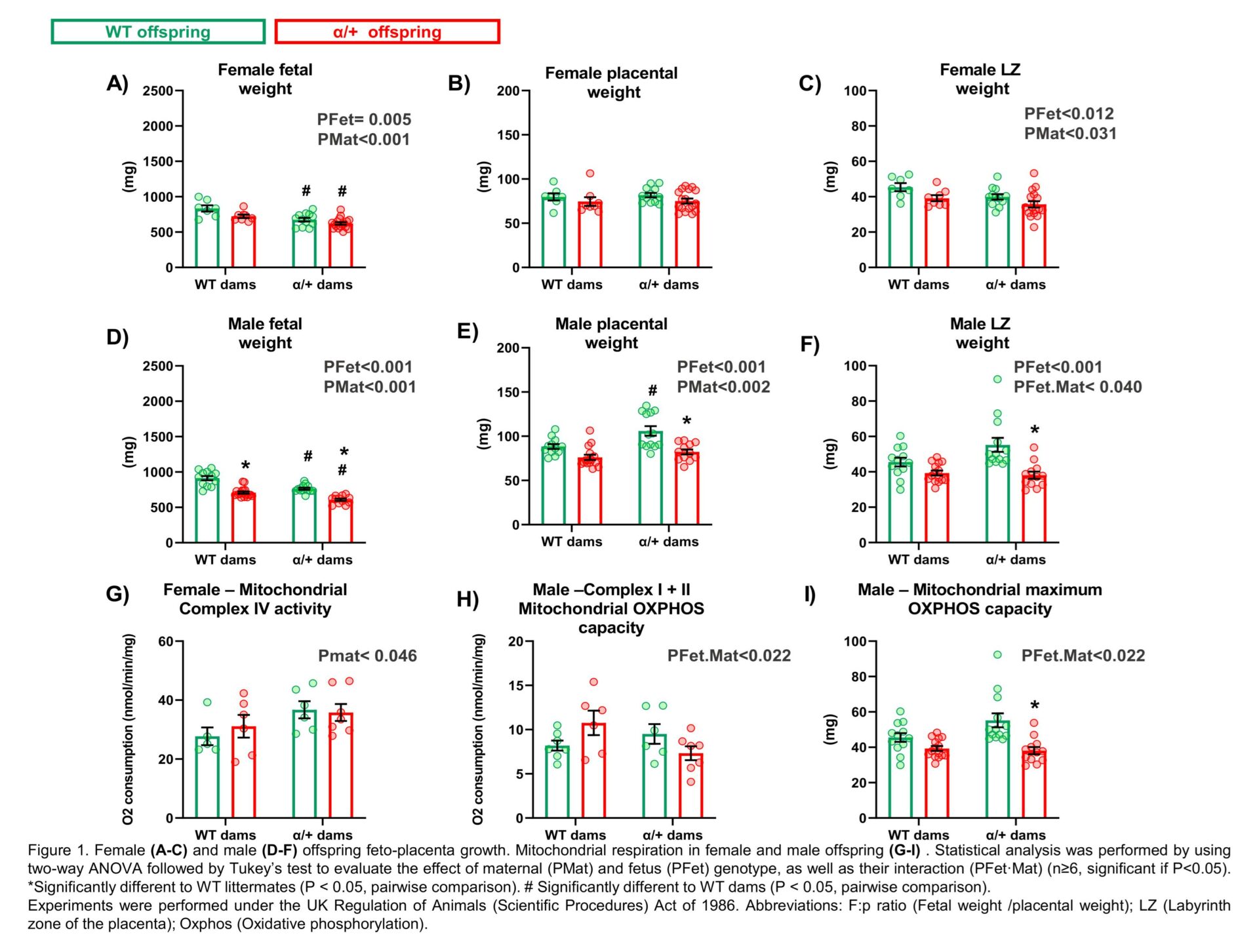Introduction: The placenta is vital for the transport of nutrients from mother to the fetus for growth. The phosphoinositol 3-kinase (PI3K) pathway regulates growth in relation to nutrient supply. Previous work using gene manipulations in mice have demonstrated that loss of the PI3K-p110α isoform in either the fetus or mother alters placental morphology and transport capacity in line with fetal growth outcomes [1, 2]. Placental growth and transport are fueled by energy provided by mitochondria [3]. However, little is known about whether maternal and fetal PI3K-p110α deficiency may affect placental mitochondrial function, and how this may relate to growth of the female and male fetus. Aims/ objectives: In mice, determine whether loss of PI3K-p110α in the mother versus the fetus affects feto-placental growth and placental mitochondrial function in each fetal sex. Methods: Virgin 4-months-old C57BL/6 wildtype (WT) and heterozygous PI3K-p110α deficient (α/+) female mice were mated to α/+ and WT males, respectively to generate litters of mixed genotype (WT and α/+). On day 18 of pregnancy, dams (WT, n=5 and α/+ n=7) were Schedule-1 killed and each fetus and placenta in the litter was weighed. The transport labyrinth zone of the placenta (LZ) was micro-dissected, weighed and subjected to high resolution respirometry to analyze mitochondrial function. Conceptuses were genotyped and sexed by PCR. Data for each sex were analyzed using two-way ANOVA followed by Tukey’s test to evaluate the effect of maternal and fetus genotype, as well as their interaction (significant if P<0.05). Experiments were performed under the UK Regulation of Animals (Scientific Procedures) Act of 1986. Results: Female fetuses from α/+ dams were significantly lighter than those from WT dams (Fig. 1 A). There was an overall effect of maternal and fetal genotype to reduce fetal and LZ weight without a significant change in placental weight in females (Fig. 1 A-C). Male fetuses from α/+ dams were also significantly lighter than those from WT dams, and in dams of each genotype, α/+ male fetuses were lighter than WT male littermates (Fig. 1 D). Placental and LZ weights from male fetuses in α/+ dams were greater than in WT dams, however the specific effect depended on fetal genotype (Fig. 1 E and F). Placental and LZ weights were less for male α/+ than WT littermates, an effect significant in α/+, but not WT dams (Fig. 1 E and F). Overall, in females only, there was greater LZ complex IV oxidative phosphorylation in α/+ versus WT dams (Fig. 1 G). In males only, there were interactions between maternal and fetal genotype that determined LZ mitochondrial complex I+II and total oxidative phosphorylation capacities (Fig. 1 H and I). There was no effect of maternal or fetal genotype on other mitochondrial respiratory parameters assessed in the placental LZ. Conclusion: Both maternal and fetal α/+ genotype affect feto-placental growth and placental mitochondrial function in a sex-specific manner.
Physiology 2021 (2021) Proc Physiol Soc 48, PC098
Poster Communications: Maternal and fetal p110α deficiency induces sex-specific changes in feto-placental growth and placental mitochondrial function
Daniela Carvalho1, Jorge Lopez-Tello1, Esteban Salazar1, Amanda Sferruzzi-Perri1
1 Centre for Trophoblast Research, Department of Physiology, Development and Neuroscience, University of Cambridge., Cambridge, United Kingdom
View other abstracts by:
Where applicable, experiments conform with Society ethical requirements.

